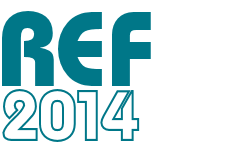![]() It’s REF week on the Research Blog and I also have to give a talk to the BU Board on Thursday about progress with our REF preparations, but I am sitting here wondering what to write? Does this often happen to you? I often put these things off and turn my hand to something else, like the paper I am currently struggling to complete, or keeping up with my email correspondence rather than tackle the task in hand. But you see, here am I avoiding starting on the piece again, so I had better get started before it gets any later.
It’s REF week on the Research Blog and I also have to give a talk to the BU Board on Thursday about progress with our REF preparations, but I am sitting here wondering what to write? Does this often happen to you? I often put these things off and turn my hand to something else, like the paper I am currently struggling to complete, or keeping up with my email correspondence rather than tackle the task in hand. But you see, here am I avoiding starting on the piece again, so I had better get started before it gets any later.
 For the Board presentation I am taking a historical view of REF and its ancestors. It started out in 1985 as the Research Selectivity Exercise, before progressing in its third iteration to the Research Assessment Exercise (RAE) in 1992 which was the first time research funds (QR – Quality Research Income) was distributed as a consequence of the outcome. In some ways it was only in 1997 that universities had really got their act together and begun to take the RAE seriously, and by 2001 it was a major focus of energy in higher education and was beginning to result in a progressive concentration of research funding in a few key institutions. BU’s greatest success to date was in 2008 when we were the fourth most improved university in the country, and for the first time BU started to receive significant QR income as a result.
For the Board presentation I am taking a historical view of REF and its ancestors. It started out in 1985 as the Research Selectivity Exercise, before progressing in its third iteration to the Research Assessment Exercise (RAE) in 1992 which was the first time research funds (QR – Quality Research Income) was distributed as a consequence of the outcome. In some ways it was only in 1997 that universities had really got their act together and begun to take the RAE seriously, and by 2001 it was a major focus of energy in higher education and was beginning to result in a progressive concentration of research funding in a few key institutions. BU’s greatest success to date was in 2008 when we were the fourth most improved university in the country, and for the first time BU started to receive significant QR income as a result.
Apart from dominating the lives of many researchers, you may well ask what it has done for UK research. Well, the answer is actually a huge ton! In the 1970s, research in UK universities was funded via a government block grant and the UK was a middle-ranking research power, complacent, inefficient and underperforming. According to the recent BIS survey with the catchy title International Comparative Performance of the UK Research Base – 2011 the UK is now a leading research nation in the world, second only to the US. The much quoted headlines run something like: 1% of the world’s population, 3% of R&D spend, 4% of researchers, but 6% of articles, 10% of citations, 14% of the most cited articles. According to HEFCE, for every pound spent on research in the UK you get between four and seven pounds back. When seen in this context, the RAE has done its job extremely well by introducing competition into the sector. There are parallels here with the current move to introduce competition around student numbers.
Since RAE2008, goal posts have changed again as the name has changed to the Research Excellence Framework (REF) with the introduction of ‘Impact’ as an element of the assessment. In 2014, it will contribute 20% of the overall profile that a Unit of Assessment (UOA) will receive. At its simplest, impact is about justifying research spending from the public purse by demonstrating the societal benefit – economic, environmental, social, or cultural – from research. It is a great concept and speaks to the heart of societal relevance which we are placing at the centre of BU’s future research strategy. It will be assessed as part of REF via a series of case studies and each case study has to be based on a piece or body of research undertaken in the last 15 years, with an evidenced impact since 2008. The basic idea is that impact often takes time to come to fruition, but for a youthful institution like our own this is challenging since the research belongs to the university where it was done, not to the researcher. In the last 5 years there has been a steady influx of talented researchers to BU, but in many cases their impact belongs to another university! 
The need to evidence societal benefit is also important – it’s not enough just to have changed government policy for example; one needs to demonstrate the benefit of that change to ordinary people. The example we often use is that of seatbelts. Professor X does some research into seat belts and convinces government to legislate with respect to their introduction. This only counts, however, as interim impact – to complete the case study, one would have to demonstrate how that legislation has reduced road traffic accidents. So evidencing one’s claim is critical. I have used this example on several occasions but was somewhat challenged when an individual in the audience pointed out that this could also be construed in a negative way since seatbelts have reduced the number of organ donors! You will no doubt be able to guess at this point that I was talking to staff in HSC at the time.
The point is that it is all about the narrative you build from a piece of research and how you evidence that claim. There are some challenges for us around the issue of impact, but it also offers great opportunity. So I think it is time for me to finish here and go back to working on my Board presentation.
 Next week is
Next week is  The REF will assess research excellence through a process of expert review, informed by indicators where appropriate. It will be based on HEIs submitting evidence of their research activity and outcomes, to be assessed by expert panels.
The REF will assess research excellence through a process of expert review, informed by indicators where appropriate. It will be based on HEIs submitting evidence of their research activity and outcomes, to be assessed by expert panels.










 Final Bournemouth University publication of 2025
Final Bournemouth University publication of 2025 On Christmas Day in the Morning…
On Christmas Day in the Morning… New Nepal scoping review on maternal & neonatal health
New Nepal scoping review on maternal & neonatal health Fourth INRC Symposium: From Clinical Applications to Neuro-Inspired Computation
Fourth INRC Symposium: From Clinical Applications to Neuro-Inspired Computation ECR Funding Open Call: Research Culture & Community Grant – Application Deadline Friday 12 December
ECR Funding Open Call: Research Culture & Community Grant – Application Deadline Friday 12 December MSCA Postdoctoral Fellowships 2025 Call
MSCA Postdoctoral Fellowships 2025 Call ERC Advanced Grant 2025 Webinar
ERC Advanced Grant 2025 Webinar Horizon Europe Work Programme 2025 Published
Horizon Europe Work Programme 2025 Published Horizon Europe 2025 Work Programme pre-Published
Horizon Europe 2025 Work Programme pre-Published Update on UKRO services
Update on UKRO services European research project exploring use of ‘virtual twins’ to better manage metabolic associated fatty liver disease
European research project exploring use of ‘virtual twins’ to better manage metabolic associated fatty liver disease